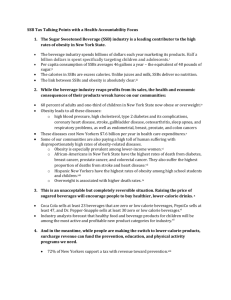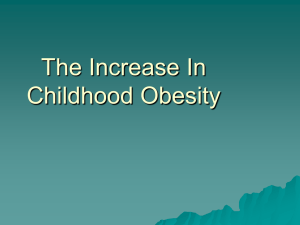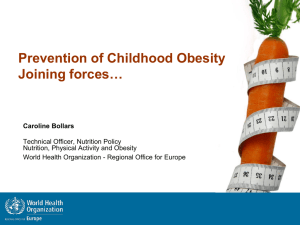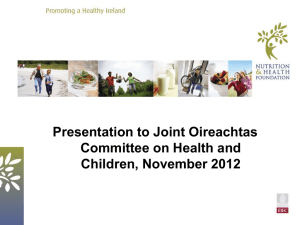Accelerating Progress in Obesity Prevention
advertisement
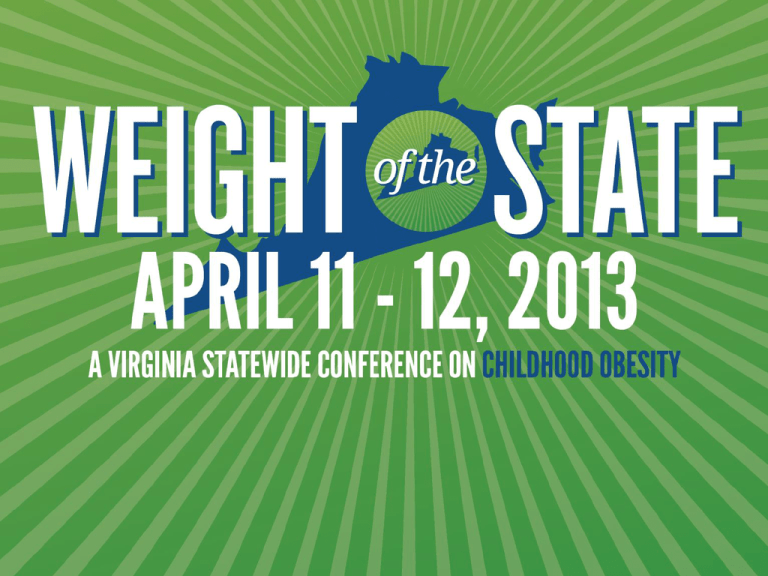
Lynn Parker, Institute of Medicine Weight of the State Virginia Health Foundation April 11, 2013 3 Where are we now? 4 Health Consequences 5 Health Consequences OBESITY CAN CAUSE OTHER HEALTH PROBLEMS Cardiovascular Disease Type 2 Diabetes High Blood Pressure Sleep Apnea Depression 6 Health Consequences 7 Scope and Societal Costs 8 9 HBO/IOM’s The Weight of the Nation HBO/IOM/CDC/NIH/Michael & Susan Dell Foundation/Kaiser Permanente •Documentaries (4) for adult audience •Short documentaries (12) on specific topics in obesity prevention •Trade publication for general audiences (The Weight of the Nation) •Website (http://theweightofthenation.hbo.com/) •Social media (Facebook, Twitter, Youtube, and GetGlue) •Screening kits with discussion guides •Marketing efforts, including reaching families with children •Documentaries (3) for children and families •Written materials for school-age children and teachers (Scholastic, Inc.) 10 Committee on Accelerating Progress in Obesity Prevention 11 Committee Membership Daniel Glickman (chair), The Aspen Institute and Bipartisan Policy Center M.R.C. Greenwood (vice chair), University of Hawaii System William Purcell (vice chair), Jones Hawkins & Farmer David Britt, retired Sesame Workshop Jamie Chriqui, University of Illinois, Chicago Patricia Crawford, University of California Christina Economos, Tufts University Sandra Hassink, A.I. duPont Hospital for Children Anthony Iton, The California Endowment Steven Kelder, University of Texas Harold (Bill) Kohl, University of Texas Shiriki Kumanyika, University of Pennsylvania Philip Marineau, LNK Partners Vicky Rideout, VJR Consulting Eduardo Sanchez, Blue Cross and Blue Shield of Texas Ellen Wartella, Northwestern University 12 13 Review of Prior Recommendations ~ 800 obesity prevention-related recommendations! Comprehensive review reflecting • • • • • • • • • • • • Institute of Medicine and National Research Council Childhood Obesity Action Network Healthy Eating Activity Living Convergence Partnership US Department of Health and Human Services (CDC, Community Preventive Services Task Force) Keystone Forum National Governors Association National Association of County and City Health Officials National Physical Activity Plan Robert Wood Johnson Foundation Trust for America’s Health USDA White House 14 Goals 1. Integrate Physical Activity Every Day in Every Way 2. Make Healthy Foods Available Everywhere 3. Market What Matters for a Healthy Life 4. Activate Employers and Health Care Professionals 5. Strengthen Schools as the Heart of Health 15 16 Physical Activity: Recommendation 1 Communities, transportation officials, community planners, health professionals, and governments should make promotion of physical activity a priority by substantially increasing access to places and opportunities for such activity. 17 Physical Activity Strategies Strategy 1-1: Enhance the physical and built environment. Strategy 1-2: Provide and support community programs designed to increase physical activity. Strategy 1-3: Adopt physical activity requirements for licensed child care providers. Strategy 1-4: Provide support for the science and practice of physical activity. 18 Food and Beverage Environments: Recommendation 2 Governments and decision makers in the business community/private sector should make a concerted effort to reduce unhealthy food and beverage options and substantially increase healthier food and beverage options at affordable, competitive prices. 19 Food and Beverage Strategies Strategy 2-1: Adopt policies and implement practices to reduce overconsumption of sugar-sweetened beverages. Strategy 2-2: Increase the availability of lower-calorie and healthier food and beverage options for children in restaurants. Strategy 2-3: Use strong nutritional standards for all foods and beverages sold or provided through the government, and ensure that these healthy options are available in all places frequented by the public. Strategy 2-4: Use financial incentives and zoning strategies to improve local food environments, linking incentives to stores that commit to healthy food promotion. Strategy 2-5: Examine the effects of U.S. agriculture policies on diets and obesity. 20 Message Environment: Recommendation 3 Industry, educators, and governments should act quickly, aggressively, and in a sustained manner on many levels to transform the environment that surrounds Americans with messages about physical activity, food, and nutrition. 21 Messaging Strategies Strategy 3-1: Develop and support a sustained, targeted physical activity and nutrition social marketing program. Strategy 3-2: Implement common standards for marketing foods and beverages to children and adolescents. Strategy 3-3: Ensure consistent nutrition labeling for the front of packages, retail store shelves, and menus and menu boards that encourages healthier food choices. Strategy 3-4: Adopt consistent nutrition education policies for federal programs with nutrition education components. 22 Health Care, Insurers, and Work Sites: Recommendation 4 Health care and health service providers, employers, and insurers should increase the support structure for achieving better population health and obesity prevention. 23 Health Care, Insurers, and Worksites Strategies Strategy 4-1: Provide standardized care and advocate for healthy community environments. Strategy 4-2: Ensure coverage of, access to, and incentives for routine obesity prevention, screening, diagnosis, and treatment. Strategy 4-3: Encourage active living and healthy eating at work. Strategy 4-4: Encourage healthy weight gain during pregnancy and breastfeeding, and promote breastfeeding-friendly environments. 24 Schools: Recommendation 5 Federal, state, and local government and education authorities, with support from parents, teachers, and the business community and the private sector, should make schools a focal point for obesity prevention. 25 School Strategies Strategy 5-1: Require quality physical education and opportunities for physical activity in schools. Strategy 5-2: Ensure strong nutritional standards for all foods and beverages sold or provided through schools. Strategy 5-3: Ensure food literacy, including skill development, in schools. 26 27 Five Interacting Areas 28 Meeting the Challenge of Achieving Equity Transform inequitable environments ● Food and Beverage ● Physical Activity ● Message Target Critical Settings ● School ● Worksites 29 • Engagement • Leadership and Responsibility •Assessment 30 31 • The Robert Wood Johnson Foundation • Michael & Susan Dell Foundation (Measuring Progress in Obesity Prevention: Workshop Report). Study Staff: Lynn Parker, Leslie Sim, Heather Cook, Emily Ann Miller, Heather Breiner, Elena Ovaitt, and Matt Spear 32 To read more about the project and download the full reports, visit: http://www.iom.edu/acceleratingobesityprevention 33 For more information on obesity, visit: http://www.iom.edu/obesity Thank you! 34


